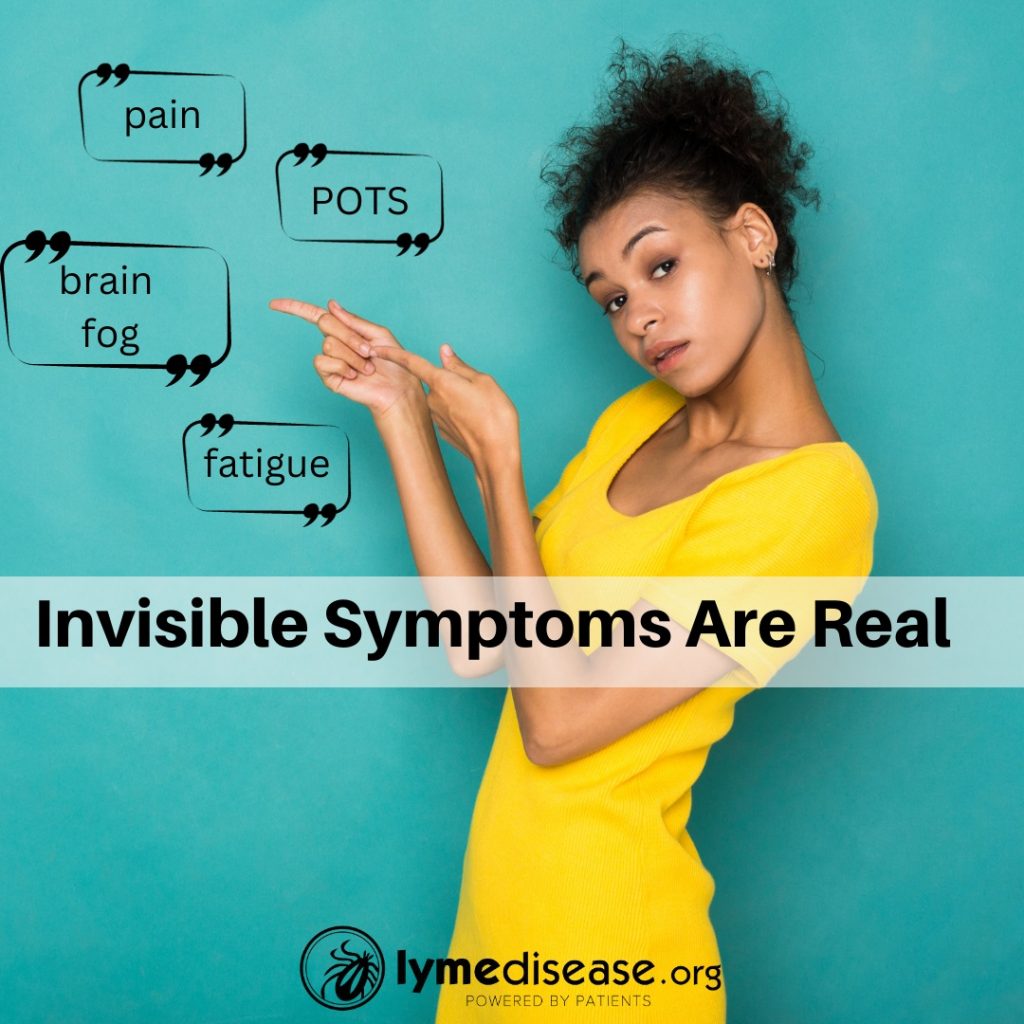An “invisible” disability is still real

Every day, we may encounter individuals who appear perfectly healthy on the outside, yet beneath the surface, are grappling with a multitude of symptoms, challenges, and limitations.
These hidden battles are the focus of Invisible Disabilities Week, which this year is October 15-21. It’s dedicated to raising awareness and understanding of the often-unnoticed struggles faced by millions of individuals around the world.
While some physical disabilities are obvious to others, many people live with conditions that are not outwardly apparent. Such invisible disabilities can encompass a wide range of health issues including chronic pain, chronic fatigue, and autoimmune diseases.
People with chronic Lyme disease often fall into this category. They may look perfectly healthy on the outside but suffer daily from fatigue, joint pain, numbness, sleep disturbance, and more.
On the day we took my daughter’s high school senior photos, no one would have guessed that she was living in chronic pain, with severe fatigue and POTS caused by the damage of tick-borne infections. No one would have guessed that we’d had to cancel her photo shoot twice due to her invisible disabilities.
She looked beautiful on the outside. In fact, one of the photos made it into the Senior Style Magazine “Featuring the Top 100 Senior Images and Photographers Across the Globe.” She is a perfect example of someone with an invisible illness who has learned to mask her symptoms for short periods.
Infection, NOT functional disorder
A functional disorder, also known as a functional somatic syndrome or functional symptom disorder, refers to a group of medical conditions in which a person experiences physical symptoms that appear to have no underlying infectious or structural cause.
In other words, when standard medicine can’t identify any physiological reason for your symptoms, they lump you into the category of functional disorders—a psychiatric condition.
In contrast, infection-associated chronic illness has a physical root cause. As I recently highlighted, several academic research centers (Johns Hopkins, Columbia, Mount Sinai, Tufts, Yale and MIT) have begun focusing on this—addressing the underlying causes of chronic illness.
At the NASEM conference this past June, David Putrino, PhD, who will serve as the Director of the new Cohen Center for Recovery From Complex Chronic Illness at Mount Sinai, said something that really resonated with me.
“I treat patients who are experiencing damage in their body from having been infected by a bacteria or a virus or are still experiencing damage because of ongoing infection with the bacteria or virus,” he said. “We do not treat functional disorders. And this is a hill I’m willing to die on!”
This means that rather than simply treating symptoms, these new research centers will investigate the possibility of infection as a trigger, and other factors that may contribute to chronic illness. This is GOOD news!
Burden of proof
Because of insensitive lab testing, people with Lyme disease are often told there’s nothing wrong with them—even though they may feel awful. This puts the burden on them, to prove they are sick and not fabricating their symptoms.
Furthermore, the symptoms of neurological Lyme disease are largely invisible and difficult to quantify. Thus, many physicians write them off as psychosomatic, leaving these patients with no validation or treatment options.
In MyLymeData, now with over 17,000 enrolled, only 7% of patients were diagnosed correctly by the first physician they saw. In fact, over 50% of participants saw seven or more physicians before receiving a proper diagnosis.
It’s time-consuming and expensive to see multiple physicians. Moreover, coordinating care and navigating a medical system that doesn’t believe you are sick is physically exhausting and emotionally traumatizing.
As retired Air Force pilot Col. Nicole Malachowski told the federal Tick-borne Disease Working Group in 2022, “Think about it: I’ve been shot at in combat, but that is not what caused my PTSD. It was caused by the unnecessary controversy surrounding Lyme disease, years of gaslighting, abandonment and betrayal by the Department of Defense, an abysmal lack of education and awareness by front-line clinicians, poor diagnostics, therapeutic standards that did not cure me, and a VA disability system that fails to understand chronic tick-borne illness.”
Fatigue is real
Even if you’ve received a proper diagnosis, and your clinician is treating you for a known infection, it is often not a straight line to healing. Persistent infection, immune evasion, physical damage, autoimmunity and immune dysregulation can all factor into why treatment sometimes doesn’t work.
Some infections cause immune suppression and can result in latent illnesses coming back to life. Epstein-Barr virus and Bartonella infections are famous for lying dormant and then raising their ugly heads when the immune system crashes.
And if the infection has spread to the brain, psychological symptoms may be prevalent, especially in children. The key is to find what triggered it and administer proper treatment.
In MyLymeData, fatigue is the number one reported symptom among patients with acute and chronic Lyme disease. The fatigue suffered by patients with chronic illness is not the same as what a healthy person feels after working or playing too hard. The fatigue I’m talking about is disabling.
For example, when my daughter was at her worst, it would take her a full week of bedrest to recover from a single visit to the doctor or the laboratory for a blood draw.
Last month, Dr. Wes Ely, a physician and professor at the school of medicine of Vanderbilt University, posted on X (formerly Twitter) “a Doctor’s admission.” In the thread, he says, “I didn’t think #MECFS was real till #LongCOVID opened my eyes.”
Dr. Ely continues, “Long COVID & ME/CFS are real medical problems that fall in the family of Post-Infectious Syndromes. The list of infectious diseases linked to long term symptoms includes, EBOLA, West Nile virus, polio, and Lyme disease…” As of today, over 232,000 people have viewed that thread.
Invisible symptoms are real
Fatigue, chronic pain, sleep disturbance, cognitive impairment and headaches are real symptoms experienced by those living with invisible illness. All of these are subjective symptoms and difficult to describe accurately and because of this you may not be taken seriously by your physician.
In Olivia Goodreau’s book, But She Looks Fine, she writes six letters aimed at the outside world. In the letter “Dear Doctors,” she writes, “I’m just asking you to believe your patients. And believe in yourself. Believe that you can figure out what’s the matter. Believe that you can be a real healer and make a difference in someone’s life. Is that too much to ask? I don’t think so.”
Hopefully, Invisible Disabilities Week will help shed light on those whose health challenges aren’t immediately noticeable—but are very real. Let us break down those stereotypes and misconceptions. Celebrate their resilience, honor their experiences and work towards a more inclusive, compassionate and understanding society.
LymeSci is written by Lonnie Marcum, a physical therapist and mother of a daughter with Lyme. She served two terms on a subcommittee of the federal Tick-Borne Disease Working Group. Follow her on Twitter: @LonnieRhea Email her at: lmarcum@lymedisease.org.
Resources
How to ask for help when you’re sick
Things not to say to people with Lyme and other invisible illnesses
What the chronically ill DO want to hear you say
12 ways you can help yourself manage chronic pain
Post-infectious fatigue and your vagus nerve (with 15 self-help recommendations
Coping with POTS in conjunction with chronic Lyme disease
Don’t medically abandon people with neurological Lyme
Finding happiness even when you’re chronically ill





















We invite you to comment on our Facebook page.
Visit LymeDisease.org Facebook Page